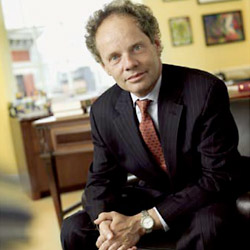It is a point of pride for me that the NYU School of Law, while teaching students how to become exceptional lawyers, makes a concerted effort to instill the value, indeed, the obligation, of public service. Among top law schools, we graduate the most students who go into public-interest law. But that doesn’t even tell the whole story, as graduates who work at firms do pathbreaking pro bono work, and some balance private practice with significant civic engagement.
 Among the driving forces of public-interest law at NYU are the Clinical and Advocacy Programs, directed by Professor Randy Hertz. About half of our students will take at least one of more than two dozen clinics before graduating. The wide selection of clinics spans criminal and civil prosecution and defense, international human rights advocacy and environmental law, and nonlitigation practices like public-policy reform and mediation. Working on important cases, the students provide much-needed legal services largely to disadvantaged clients in New York and, increasingly, in communities throughout the nation and the world. Each year, we examine an area of law in which I am confident that a peer review would say we lead the way among the top law schools. Read about the genesis and growth of this year’s example, the clinical program, in “Bringing the Law to Life” by Clint Willis and Suzanne Barlyn.
Among the driving forces of public-interest law at NYU are the Clinical and Advocacy Programs, directed by Professor Randy Hertz. About half of our students will take at least one of more than two dozen clinics before graduating. The wide selection of clinics spans criminal and civil prosecution and defense, international human rights advocacy and environmental law, and nonlitigation practices like public-policy reform and mediation. Working on important cases, the students provide much-needed legal services largely to disadvantaged clients in New York and, increasingly, in communities throughout the nation and the world. Each year, we examine an area of law in which I am confident that a peer review would say we lead the way among the top law schools. Read about the genesis and growth of this year’s example, the clinical program, in “Bringing the Law to Life” by Clint Willis and Suzanne Barlyn.
Behind the success of the clinics is a talented and devoted faculty. These 15 full-time professors share a deep commitment to helping their fellow human beings. In fascinating in-depth profiles of two of them, Anthony Amsterdam and Bryan Stevenson, you get a sense of why and how they do it. Tony is a legend among deathpenalty opponents for his argument in Furman v. Georgia that reversed capital punishment in the early 1970s. Now in his 70s, he remains one of the busiest attorneys I know, but has been working quietly out of the public eye. Nadya Labi has produced a lucid portrait of Amsterdam’s influence on and enduring contribution to the law and to history, “A Man Against the Machine.”
The Law School has a unique relationship with Bryan, who teaches a capital-defender clinic that takes place in both New York and Montgomery, Alabama, where Bryan’s Equal Justice Initiative is a sorely needed resource. On behalf of several indigent death-row clients, Bryan recently petitioned the Supreme Court to revisit their right to counsel for appeals. Alabama is the only state that denies postconviction legal aid to prisoners facing execution. Although the Court didn’t grant certiorari, Bryan was supported by the New York Times and five Alabama newspapers; that alone is a feat. In “Bryan Stevenson’s Death-Defying Acts,” Paul Barrett reveals the powerful influences that move Bryan to represent the mostdespised among us.
I am enormously proud of all our faculty and pleased to welcome four new members.
On a more personal note, having reached a five-year milestone, I’ve had a chance to reflect on the incredible privilege of being dean of this outstanding law school. The students, faculty, centers, programs and institutes continue to amaze me with their energy, ideas and influence. In the past year, Fed Chairman Ben Bernanke spread his free-market message, Archbishop Desmond Tutu remembered the truth commissions, retired Justice Sandra Day O’Connor defended the judiciary, and dozens of influential policymakers and lawyers spent time on our campus. Our students organized a school-funded alternative spring break, performed spectacularly in moot court competitions, and one even argued and won a Minnesota Court of Appeals case. At convocation, I was moved by the speech given by Omer Granit, an Israeli, and Rayan Houdrouge, a Lebanese, both LL.M.-degree recipients, who shared how their unlikely friendship developed here.
I spoke with reporter Kelley Holland about my first five years as dean and my future plans in this issue’s “Dean’s Discourse,” but to get the full flavor of the accomplishments, activities and scholarship of the Law School’s talented members, you’ll really have to read the whole magazine. Enjoy!
